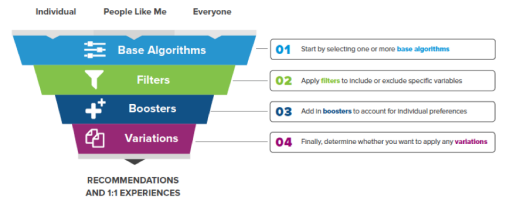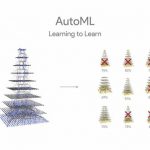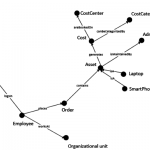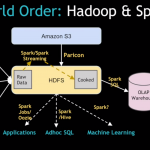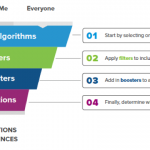The Main Elements of Machine-Learning Personalization
— September 1, 2017

422737 / Pixabay
More and more, marketers across industries are figuring out how to use machine learning in their marketing. They are discovering that machine learning is critical for communicating with customers and prospects at the individual level. For those who need a quick definition: machine-learning personalization utilizes algorithms and predictive analytics to dynamically present the most relevant content or experience for each and every visitor at the one-to-one level.
Machine-learning personalization provides a scalable way to personalize any and all aspects of your website. While using machine learning for personalization can sound overwhelming to marketers who have never personalized before, or have historically only used rules for personalization, setting up your own custom strategy – or what we call “recipes” – can be easy with the right solution. There are four main components to each recipe: base algorithms, filters, boosters and variations.
In this blog post, I’ll outline each of these components.

Base Algorithms
Base algorithms are the foundation for delivering recommendations and individualized experiences. When choosing a base algorithm, you guide the system on where to begin when selecting items to recommend or experiences to show.
Base algorithms can be basic or advanced. Basic algorithms generally rely on specific criteria or the “wisdom of the crowd.” For example, “trending,” “recently published” and “co-browse” are popular basic algorithms that will display products or content that are popular on the site, new on the site, or that are based on what others have also viewed. Note that these commonly used algorithms produce unpersonalized recommendations on their own (although they can become personalized with the addition of boosters, which I’ll cover later on in the post). Rather, they are based on overall site popularity or behavior and don’t take into consideration an individual’s preferences/affinities to determine experiences.
Advanced algorithms, on the other hand, are more sophisticated. They continue to learn as visitors engage with the site and produce personalized experiences without necessarily adding boosters. One popular advanced algorithm is collaborative filtering. Based on a visitor’s engagement with different items, he is grouped into a cluster of people with similar likes and dislikes. Items are then recommended by comparing him to others in his cluster. Netflix, for example, uses this technique. Let’s look at an example of a B2B site focused on demand generation. Assume the B2B site displays a thank you page after a prospect registers for a webinar. The site’s marketing team may want to feature a few relevant content assets for her to engage with after she registers in order to keep her engaged on the site rather than reach a dead-end page.
Let’s look at an example of a B2B site focused on demand generation. Assume the B2B site displays a thank you page after a prospect registers for a webinar. The site’s marketing team may want to feature a few relevant content assets for her to engage with after she registers in order to keep her engaged on the site rather than reach a dead-end page.
The marketing team could opt to select a trending base algorithm, which would recommend the content assets that are most popular on the site at that time. Or, the team could select a collaborative filtering algorithm to display more tailored recommendations.
Filters
After you’ve picked one or more base algorithms, you can customize them by including or excluding certain criteria using filters. Filters allow you to exercise control over the categories, brands, price ranges, locations and other attributes that are shown in your recommendations. In other words, you can add human guidance to your machine learning-driven experiences.
Continuing with the thank you page example above, regardless of the base algorithm selected, the site’s marketing team may want to exclude webinars as a content type for that page (since she is already currently registered for one), and instead feature other asset types that she can peruse immediately. Or, they could opt to include only those content assets that align with a particular topic due to the team’s marketing calendar.
Boosters
Next, boosting allows you to incorporate and prioritize the specific preferences in brand, category, price range, color, gender, content type, keyword, etc., of each individual on your site. These preferences can be determined with deep behavioral tracking on each individual — incorporating not just what a visitor clicks on, but also mouse movement, scrolling, inactivity and time spent per page — to give a clear indication of preference and level of interest.
When you’re able to deeply track behaviors on your site, you can uncover the individual preferences and affinities of each visitor and use that information to “boost” the results of your algorithms and make them even more relevant at the one-to-one level. While advanced algorithms are already relevant at the one-to-one level, boosting allows you provide individualized experiences even with basic algorithms.
As an example, the thank you page recommendations could include boosters that prioritize content in the visitor’s preferred industry or content types that the visitor prefers, such as blog posts, case studies, whitepapers, etc.
Variations
Finally, you can decide to include some variations in your recipe. These can take several forms. For example, you can set your homepage recommendations to be randomized (while still being relevant to each individual) so they stay fresh, or you could cap the number of times you show a recommendation to a person to minimize apathy. Like all of the other elements of a machine-learning algorithm described in this blog post, whether or not you include a variation and which variation you choose is completely up to you. It depends on what you think will be most effective for the needs of your particular site visitors.
To wrap up the thank you page example, if a visitor has seen a particular eBook across the site multiple times but never downloaded it, instead of including it on the thank you page, the site can include variations to shake up the recommendations for her so they don’t become stale.
Final Thoughts
Many personalization solutions aren’t transparent about what comprises their algorithms. And they don’t allow you to build your own “recipes,” to completely tailor the machine learning initiatives to your needs or continue to test and tweak them until you are satisfied with the results. To learn more about why this is important, check out this blog post.
Business & Finance Articles on Business 2 Community
(23)

